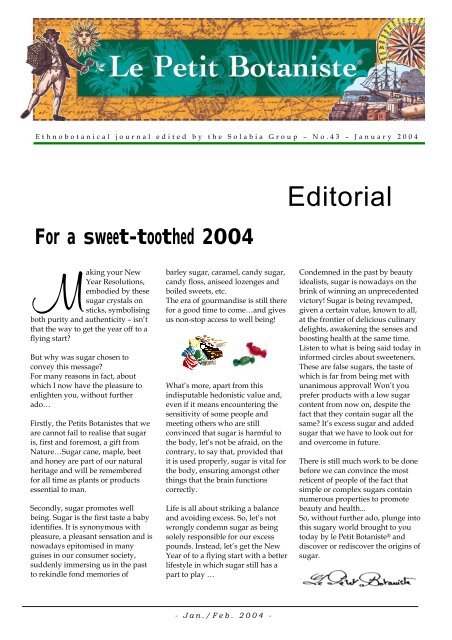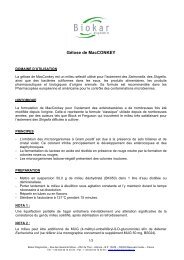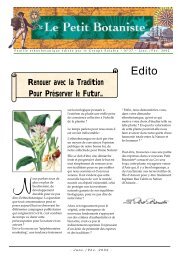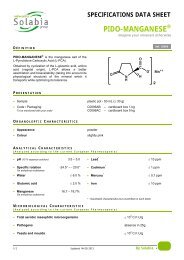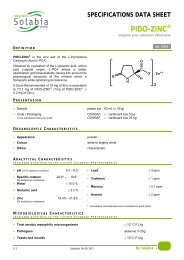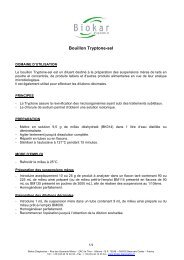Sugar, a gift of nature - Solabia Group
Sugar, a gift of nature - Solabia Group
Sugar, a gift of nature - Solabia Group
You also want an ePaper? Increase the reach of your titles
YUMPU automatically turns print PDFs into web optimized ePapers that Google loves.
Ethnobotanical journal edited by the <strong>Solabia</strong> <strong>Group</strong> – No.43 – January 2004<br />
For a sweet-toothed 2004<br />
Making your New<br />
Year Resolutions,<br />
embodied by these<br />
sugar crystals on<br />
sticks, symbolising<br />
both purity and authenticity – isn’t<br />
that the way to get the year <strong>of</strong>f to a<br />
flying start?<br />
But why was sugar chosen to<br />
convey this message?<br />
For many reasons in fact, about<br />
which I now have the pleasure to<br />
enlighten you, without further<br />
ado…<br />
Firstly, the Petits Botanistes that we<br />
are cannot fail to realise that sugar<br />
is, first and foremost, a <strong>gift</strong> from<br />
Nature…<strong>Sugar</strong> cane, maple, beet<br />
and honey are part <strong>of</strong> our natural<br />
heritage and will be remembered<br />
for all time as plants or products<br />
essential to man.<br />
Secondly, sugar promotes well<br />
being. <strong>Sugar</strong> is the first taste a baby<br />
identifies. It is synonymous with<br />
pleasure, a pleasant sensation and is<br />
nowadays epitomised in many<br />
guises in our consumer society,<br />
suddenly immersing us in the past<br />
to rekindle fond memories <strong>of</strong><br />
barley sugar, caramel, candy sugar,<br />
candy floss, aniseed lozenges and<br />
boiled sweets, etc.<br />
The era <strong>of</strong> gourmandise is still there<br />
for a good time to come…and gives<br />
us non-stop access to well being!<br />
What’s more, apart from this<br />
indisputable hedonistic value and,<br />
even if it means encountering the<br />
sensitivity <strong>of</strong> some people and<br />
meeting others who are still<br />
convinced that sugar is harmful to<br />
the body, let’s not be afraid, on the<br />
contrary, to say that, provided that<br />
it is used properly, sugar is vital for<br />
the body, ensuring amongst other<br />
things that the brain functions<br />
correctly.<br />
Life is all about striking a balance<br />
and avoiding excess. So, let’s not<br />
wrongly condemn sugar as being<br />
solely responsible for our excess<br />
pounds. Instead, let’s get the New<br />
Year <strong>of</strong> to a flying start with a better<br />
lifestyle in which sugar still has a<br />
part to play …<br />
- Jan./Feb. 2004 -<br />
Editorial<br />
Condemned in the past by beauty<br />
idealists, sugar is nowadays on the<br />
brink <strong>of</strong> winning an unprecedented<br />
victory! <strong>Sugar</strong> is being revamped,<br />
given a certain value, known to all,<br />
at the frontier <strong>of</strong> delicious culinary<br />
delights, awakening the senses and<br />
boosting health at the same time.<br />
Listen to what is being said today in<br />
informed circles about sweeteners.<br />
These are false sugars, the taste <strong>of</strong><br />
which is far from being met with<br />
unanimous approval! Won’t you<br />
prefer products with a low sugar<br />
content from now on, despite the<br />
fact that they contain sugar all the<br />
same? It’s excess sugar and added<br />
sugar that we have to look out for<br />
and overcome in future.<br />
There is still much work to be done<br />
before we can convince the most<br />
reticent <strong>of</strong> people <strong>of</strong> the fact that<br />
simple or complex sugars contain<br />
numerous properties to promote<br />
beauty and health...<br />
So, without further ado, plunge into<br />
this sugary world brought to you<br />
today by le Petit Botaniste ® and<br />
discover or rediscover the origins <strong>of</strong><br />
sugar.
Le Petit Botaniste ® <strong>Sugar</strong> – a <strong>gift</strong> <strong>of</strong> <strong>nature</strong><br />
O<br />
nce upon a time there was the<br />
sugar epic – an adventure<br />
brimming with an<br />
overwhelming desire to get to grips<br />
with the history <strong>of</strong> Mankind<br />
through that <strong>of</strong> plants …<br />
The <strong>Sugar</strong> Epic…<br />
Almost three thousand years ago, or<br />
thereabouts, the Chinese or the<br />
Indians (no-one really knows<br />
which), invented the very first<br />
techniques for extracting “sarkara”<br />
or sugar in Sanskrit from a tall<br />
tropical plant (sugar cane).<br />
Around 510 B.C. it was the turn <strong>of</strong><br />
the Persians to discover sugar but it<br />
was only in 310 B.C. that the<br />
extremely famous Alexander the<br />
Great came across this famous “reed<br />
that produced honey without<br />
involving the bees”! He took it back<br />
with him to the West.<br />
And so the great history <strong>of</strong> sugar<br />
began! Both the Romans and the<br />
Greeks discovered its beneficial<br />
properties and used it for<br />
therapeutic purposes.<br />
In the VI th century, sugar cane<br />
consolidated its presence in Iran<br />
and the first sugar loaves were<br />
produced, thus making it easier to<br />
transport the sugar. The fame <strong>of</strong><br />
sugar cane thus spread through a<br />
series <strong>of</strong> adventures, including Arab<br />
adventures, these famous<br />
conquerors who defied people all<br />
over the world. The Crusaders also<br />
introduced the sweet properties <strong>of</strong><br />
this herb to their respective<br />
countries.<br />
In Palestine, Egypt, Syria as well as<br />
Spain, Greece, Italy, Cypress and<br />
Malta, sugar cane developed on all<br />
continents.<br />
Alexander the Great<br />
(356-323 BC.)<br />
Olivier de Serres<br />
(1539-1619)<br />
In the XIV th century, Venice<br />
acquired the sugar trade monopoly<br />
and the first refineries were<br />
constructed in 1450. Gradually, the<br />
history <strong>of</strong> sugar will leave Europe to<br />
conquer more far-<strong>of</strong>f climes …<br />
In search <strong>of</strong> the<br />
<strong>Sugar</strong> isles…<br />
In 1492, Christopher Columbus<br />
discovered America.<br />
One year later, the Genoese<br />
navigator set sail for the West Indies<br />
and Cuba. In St Domingo, he sowed<br />
the first sugar cane plants. It was<br />
then the turn <strong>of</strong> the Caribbean<br />
Islands to don the title <strong>of</strong> “the sugar<br />
isles”. Meanwhile, the Portuguese<br />
had taken both the method and the<br />
equipment to Brazil.<br />
During the XVIII th century, St<br />
Domingo, Martinique and<br />
Guadeloupe shared the cultivation<br />
<strong>of</strong> the cane whilst refineries<br />
multiplied in towns and cities.<br />
<strong>Sugar</strong> which, by now had become a<br />
luxury product, was henceforth the<br />
first, major international economic<br />
and political stake, and the world<br />
witnessed the dreadful trafficking <strong>of</strong><br />
slaves and the unleashing <strong>of</strong> war,<br />
the sole aim <strong>of</strong> which was to<br />
conquer the sugar trade. This was<br />
fundamentally the reason behind<br />
the second 100 years war between<br />
the French and the English.<br />
MAJOR FIGURES IN THE SUGAR EPIC<br />
Andreas Sigismund<br />
Marggraf (1709-1782)<br />
- Jan./Feb. 2004 -<br />
Franz Carl Achard<br />
(1753-1821)<br />
A new approach<br />
Beet …<br />
The history <strong>of</strong> mankind will, once<br />
again, disrupt that <strong>of</strong> sugar.<br />
In fact, the revolution <strong>of</strong> 1789 and<br />
the French-English conflicts<br />
followed, causing prices to shoot<br />
up. <strong>Sugar</strong> was thus rationed.<br />
A new era was dawning – that <strong>of</strong><br />
beet. As far back as 1600, the<br />
famous agronomist, Olivier de<br />
Serres, had commented that, when<br />
cooking, beet produces a juice<br />
similar to sugar syrup. In 1745, a<br />
German, Andreas Sigismund<br />
Marggraf, focused on other plants<br />
with a sugary taste, and succeeded<br />
in extracting sugar from beet, albeit<br />
with a very low yield. His pupil,<br />
Franz Carl Achard, actually went on<br />
to produce the first beet sugar in<br />
1798. The first production plant was<br />
therefore built in Silesia (Poland)<br />
with the assistance <strong>of</strong> Frédéric<br />
Guillaume III but was not that<br />
successful. For his part, Napoleon<br />
1st continued his research with a<br />
passion, hence in 1811, Benjamin<br />
Delessert developed in Passy the<br />
sugar refining, purifying and<br />
packaging process.<br />
The production <strong>of</strong> beet witnessed a<br />
major growth spurt with the<br />
continental European blockade in<br />
1806, which stopped the<br />
importation <strong>of</strong> sugar. The abolition<br />
<strong>of</strong> slavery lent credibility to beet.<br />
Since the XIXth century, sugar cane<br />
and beet have therefore shared the<br />
sugar monopoly.<br />
Benjamin Delessert<br />
(1773-1847)
N<br />
Le Petit Botaniste ® <strong>Sugar</strong> – a <strong>gift</strong> <strong>of</strong> <strong>nature</strong><br />
ow let’s get back in more detail<br />
to these incredible species <strong>of</strong><br />
plant that give us sugar, also known<br />
as saccharose.<br />
Beet and <strong>Sugar</strong> Cane<br />
Belonging to the Graminae family,<br />
sugar cane<br />
(Saccharum<br />
<strong>of</strong>ficinarum), is a<br />
tall, hardy,<br />
rhizomatous plant.<br />
From these rhizomes<br />
extend cylindrical,<br />
aerial stems between 2<br />
and 5 m tall, the weight <strong>of</strong> which<br />
varies from 0.3 to 6 kg in the case <strong>of</strong><br />
the tallest. The leaves, which are<br />
rich in saccharose, are used by the<br />
sugar-refining industry.<br />
Belonging to the<br />
Chenopodiaceae<br />
family, sugar beet is<br />
a plant <strong>of</strong> Northern<br />
origin that requires a<br />
temperate climate and<br />
rich, deep soil in which to<br />
grow. The saccharose is<br />
accumulated in the root<br />
during the first year <strong>of</strong> the<br />
plant’s life. What’s more, the sugar<br />
must be harvested rapidly because<br />
it may use up all <strong>of</strong> its reserves to<br />
produce its seeds.<br />
Unfamiliar<br />
saccharified plants<br />
In tropical<br />
regions,<br />
various<br />
species <strong>of</strong><br />
palm tree are<br />
used – these<br />
are known as<br />
sugar palms:<br />
The palmyra<br />
palm<br />
(Borassus<br />
flabellifer),<br />
ronier palm (Borassus aethiopum),<br />
the sugar palm per se (Arenga<br />
pinnata) or even the Chilean coquito<br />
palm (Jubaea chilensis).<br />
In Canada and the United States,<br />
apart from being a commercial<br />
essence used for its wood, silver<br />
maple (Acer saccharum) also<br />
produces, thanks to its sap, the<br />
famous silver maple syrup, which is<br />
a delicious complement to pancakes<br />
and other culinary delights …<br />
As for sugar sorghum (Sorghum<br />
saccharum), which is grown chiefly<br />
in Asia and Africa as well as in the<br />
United States, it is the stem that<br />
contains a wealth <strong>of</strong> saccharose.<br />
Plants containing<br />
fructose<br />
Increasingly used in dietetic<br />
products since it is considered to be<br />
a slow sugar with substantial<br />
sweetening properties, fructose is<br />
fruit sugar (hence its name). For<br />
instance, it is<br />
found in high<br />
concentrations<br />
in strawberries<br />
(Fragaria chiloensis)<br />
or guava (Psidium guajava).<br />
Another plant originating from<br />
South America also comes to the<br />
fore. This is Polymnia sonchifolia, the<br />
olig<strong>of</strong>ructane composition <strong>of</strong> its<br />
tubercles being <strong>of</strong> primary interest<br />
in the food supplement industry.<br />
<strong>Sugar</strong> – a medicinal<br />
product?<br />
Despite its appearances and<br />
delicious taste, up until the XVII th<br />
century sugar was not only<br />
considered to be a luxury product,<br />
but also a genuine medicinal<br />
product to which numerous<br />
medicinal properties were<br />
attributed!<br />
But sugar is also the honey <strong>of</strong> our<br />
friends, the bees, who transform<br />
the saccharose from plant nectar<br />
into glucose and fructose. Honey<br />
is also made up <strong>of</strong> a multitude <strong>of</strong><br />
traces <strong>of</strong> other sugars, the<br />
quantitative and qualitative<br />
distribution <strong>of</strong> which can vary<br />
depending on the flower<br />
- Janv./Fév. 2004 -<br />
Dioscorides, the famous Greek<br />
physician, once said “that it is<br />
similar to salt in terms <strong>of</strong><br />
consistency and cracks beneath the<br />
teeth,” and recommended sugared<br />
water for the kidneys, stomach and<br />
bladder.<br />
It was this medicinal usage <strong>of</strong> sugar<br />
that led to the <strong>of</strong>ficial name <strong>of</strong> sugar<br />
cane: Saccharum <strong>of</strong>finarum.<br />
Continuing in this<br />
vein, Arab<br />
physicians and<br />
Avicenne in<br />
particular,<br />
unwittingly<br />
developed<br />
confectionary<br />
between the X th<br />
and XII th centuries<br />
by mixing the sugar contained in<br />
syrup with spicy powders and<br />
aromats (mint, musk and cloves,<br />
etc.) for therapeutic purposes.<br />
Then it’s <strong>of</strong>f to the West, to crave<br />
this delicious, medicinal sugar,<br />
based on the treaties <strong>of</strong> Arab<br />
medicine. In Italy, for example, the<br />
School <strong>of</strong> Salerno, one <strong>of</strong> the most<br />
famous at the time, devised typical<br />
“Diets” with health and cooking<br />
tips for the aristocracy – how the<br />
meaning <strong>of</strong> words can change over<br />
time ….<br />
In the XII th century, the Italian<br />
physician, Mésué, created<br />
therapeutic recipes such as laxative<br />
(apple, pear and quince) and<br />
stomachic (peach and prune) jams<br />
together with aniseed sweets to aid<br />
digestion, etc.<br />
from which the pollen is collected<br />
(isomaltose, nigerose, turanose,<br />
maltulose, isomaltulose, leucrose,<br />
kojibiose, neotrehalose,<br />
gentiobiose,<br />
laminaribiose and<br />
melezitose, etc.).
As for Joseph Du Chesne, known as<br />
“Mr. Violet”, he did not hesitate to<br />
talk about “food medicines” and<br />
“medicinal foods” from 1630<br />
onwards; these preparations were<br />
undoubtedly the precursors <strong>of</strong> what<br />
are referred to today in informed<br />
circles as food and drug<br />
combinations.<br />
He proposed warming syrups<br />
(artemisia, peppermint and<br />
horehound (marrubian)), refreshing<br />
syrups (barberry (berberis vulgaris),<br />
water lily and violet), or so-called<br />
temperate syrups (liquorice and hop).<br />
DO YOU KNOW ALL ABOUT<br />
SUGAR? IT HAS<br />
SOMETHING FOR EVERYONE<br />
Refined or white<br />
It contains at least 99.7% <strong>of</strong> sucrose.<br />
Brown sugar<br />
(“Roux sugar”)<br />
Contains 85 to 98% <strong>of</strong><br />
sucrose and certain<br />
impurities, which gives it its brown<br />
colour.<br />
Crystallised<br />
White sugar collected in turbines<br />
after concentration under vacuum<br />
and crystallisation <strong>of</strong> syrups.<br />
As powder (or semolina)<br />
Obtained by sieving or grinding<br />
white, crystallised sugar.<br />
Icing sugar<br />
White powder obtained by grinding<br />
white, crystallised sugar and adding<br />
starch (approx. 3%) to prevent it<br />
from forming lumps.<br />
Candy<br />
White or brown crystals<br />
obtained by slow<br />
crystallisation <strong>of</strong> a<br />
concentrated, hot, sugar syrup.<br />
Le Petit Botaniste ® Sug ar – a g i f t <strong>of</strong> <strong>nature</strong><br />
<strong>Sugar</strong> has always been<br />
an inspiration to<br />
health, to such an<br />
extent that, during the<br />
1750s, it was given a<br />
medical definition in<br />
the Encyclopaedia <strong>of</strong><br />
that time:<br />
“Everyone knows that<br />
sugar is a solid, white, sweet<br />
substance that has a pleasant taste<br />
and is widely used in dispensaries,<br />
in cooking and even in pharmacies<br />
to produce syrups and prepare<br />
several remedies, dissolving<br />
perfectly in water to which it<br />
Demerara<br />
Raw crystallised sugar, directly<br />
extracted from the juice <strong>of</strong> sugar cane,<br />
which gives it its brown colour and its<br />
flavour reminiscent <strong>of</strong> rum.<br />
“Vergeoise” sugar<br />
<strong>Sugar</strong> with a s<strong>of</strong>t<br />
consistency obtained from<br />
beet or cane syrup, which<br />
has been coloured and<br />
flavoured by the ingredients contained<br />
in its starting material<br />
Golden sugar<br />
Produced from a syrup discarded during<br />
the first sugar-spinning process.<br />
Light brown<br />
Obtained by re-heating the syrup<br />
from the 2 nd sugar-spinning process;<br />
this is the sugar used for specialist<br />
Flemish dishes.<br />
For jams<br />
White sugar containing<br />
natural fruit pectin, citric<br />
acid and, occasionally,<br />
tartaric acid for the jams to set.<br />
<strong>Sugar</strong> loaf<br />
Crystallised sugar moulded and cooled<br />
in conical moulds. This is how sugar<br />
was first used.<br />
Liquid (or sugar syrup)<br />
For punches and exotic recipes.<br />
Edited by CEP, <strong>Solabia</strong> <strong>Group</strong>,<br />
29, rue Delizy, 93698 Pantin cedex<br />
Tel.: (+33) 1 48 10 19 40 - Fax: (+33) 1 48 91 18 77<br />
Publication Manager: Jean François Molina<br />
Editorial Committee: Patricia Houy and Carine Lebeau<br />
Photo credits NC<br />
- Reproduction prohibited-<br />
lends a pleasant taste without<br />
giving it any colour or odour “.<br />
Several centuries after this<br />
memorable craze, sugars are once<br />
again the topic <strong>of</strong> conversation in<br />
the highest <strong>of</strong> scientific circles!<br />
Genuine laboratory markers, they<br />
tend to make an effective<br />
contribution to the treatment <strong>of</strong><br />
certain diseases and, very soon, will<br />
also play a key role in cosmetics.<br />
However, we’ll come back to that at<br />
a later stage – rest assured!<br />
And let’s keep the best until<br />
last…<br />
The saga <strong>of</strong> sugar moulded in<br />
pieces or the history <strong>of</strong> a<br />
technological feat…<br />
Up until 1854, sugar was available only<br />
in the form <strong>of</strong> sugar loaves as sold in<br />
grocers’ shops. Breaking up the sugar<br />
with a cleaver and a special hammer is<br />
a monotonous routine task that<br />
produces pieces <strong>of</strong> sugar that are<br />
unequal in size and not always very<br />
clean. It was therefore in 1854 that a<br />
Parisian grocer, Eugène François,<br />
investigated how to obtain regularsized<br />
pieces <strong>of</strong> sugar. The equipment<br />
he used to cut the sugar loaves into<br />
slices and then the slices into pieces<br />
was initially rather basic but adequate<br />
enough to make perfect geometrically<br />
shaped pieces <strong>of</strong> sugar available to<br />
delighted householders. He perfected<br />
his method <strong>of</strong> cutting and crushing<br />
over a period <strong>of</strong> twenty years and, in<br />
November 1875, he filed the<br />
"casseuse François" patent.<br />
Another breakthrough came in 1949<br />
with compression moulding. Louis<br />
Chambon developed the "Chambon<br />
chain", which allowed heat-moistened<br />
crystals <strong>of</strong> sugar to be pulled<br />
together.


